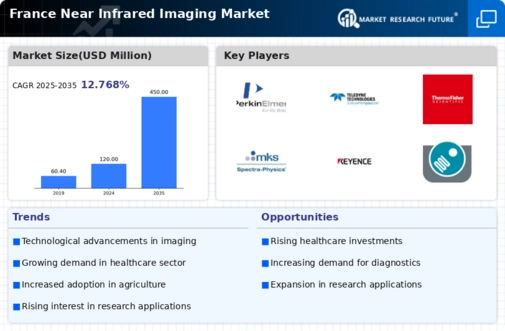Growing Demand in Healthcare
The near infrared-imaging market is experiencing a notable surge in demand within the healthcare sector in France. This growth is primarily driven by the increasing need for non-invasive diagnostic techniques that enhance patient outcomes. The technology's ability to provide real-time imaging of tissues and organs is particularly appealing to medical professionals. In 2025, the healthcare segment is projected to account for approximately 40% of the total market share, reflecting a robust trend towards advanced imaging solutions. Furthermore, the integration of near infrared-imaging in surgical procedures is likely to improve precision and reduce recovery times, thereby fostering further adoption in clinical settings. As healthcare providers seek innovative methods to enhance diagnostic accuracy, the near infrared-imaging market is poised for substantial growth in France.
Expansion of Industrial Applications
The near infrared-imaging market is witnessing an expansion in industrial applications across various sectors in France. Industries such as food and beverage, pharmaceuticals, and manufacturing are increasingly adopting this technology for quality control and process optimization. The ability to detect moisture content, chemical composition, and other critical parameters in real-time is enhancing operational efficiency. In 2025, the industrial segment is anticipated to represent approximately 30% of the market share, underscoring the technology's versatility. As industries strive for higher standards of quality and compliance, the demand for near infrared-imaging solutions is likely to rise, further propelling market growth. This trend indicates a shift towards integrating advanced imaging technologies into routine industrial processes.
Increased Focus on Environmental Monitoring
The near infrared-imaging market is gaining traction due to the heightened focus on environmental monitoring in France. As concerns regarding climate change and pollution intensify, there is a growing need for effective monitoring solutions. Near infrared imaging technology offers the capability to assess vegetation health, soil quality, and water resources, making it invaluable for environmental scientists and policymakers. In 2025, the market for environmental applications is projected to grow by 25%, reflecting the increasing reliance on advanced imaging techniques for sustainable development. This trend is likely to encourage investments in near infrared-imaging systems that can provide accurate and timely data for environmental assessments, thereby driving market growth.
Rising Investment in Research and Development
Investment in research and development (R&D) is a critical driver for the near infrared-imaging market in France. The government and private sectors are increasingly allocating funds to explore new applications and improve existing technologies. In 2025, R&D expenditure in the imaging sector is expected to reach €500 million, indicating a strong commitment to innovation. This influx of capital is likely to facilitate the development of advanced imaging systems that offer enhanced resolution and speed. Additionally, collaborations between academic institutions and industry players are fostering a conducive environment for technological breakthroughs. As new applications emerge, such as in oncology and neurology, the near infrared-imaging market is expected to expand significantly, driven by these R&D initiatives.
Growing Awareness of Health and Safety Standards
The near infrared-imaging market is benefiting from the growing awareness of health and safety standards in various sectors in France. As regulatory bodies emphasize the importance of maintaining high safety standards, industries are increasingly adopting advanced imaging technologies to ensure compliance. Near infrared imaging provides non-destructive testing capabilities that are essential for quality assurance in manufacturing and food safety. In 2025, the market is expected to see a 20% increase in demand driven by these regulatory requirements. This heightened focus on safety and quality is likely to encourage companies to invest in near infrared-imaging systems, thereby fostering market growth. The alignment of technology with regulatory standards is crucial for enhancing operational integrity across sectors.



















Leave a Comment